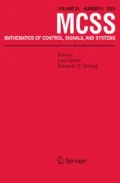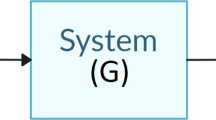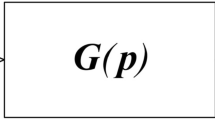Abstract
This paper presents a new approach for solving balanced realization problems with emphasis on the time-varying case. Instead of calculating the exact solutions for balancing at each time instant, we estimate with arbitrary accuracy the balancing solutions by means of Riccati equations associated with the balancing problems Under uniform boundedness conditions on the controllability and observability grammians and their inverses, the solutions of the Riccati equations exist and converge exponentially as their initial time goes to — ∞ to give what we term μ-balancing solutions. The parameter μ has the interpretation of the gain of a differential equation. It determines the accuracy of the balancing transformation tracking and the exponential rate of convergence. Their exponentially convergent behavior ensures numerical robustness.
Similar content being viewed by others
References
B. D. O. Anderson and J. B. Moore,Optimal Control: Linear Quadratic Methods, Prentice-Hall, Englewood Cliffs, NJ, 1990.
E. F. Beckenbach and R. Bellman,Inequalities, Springer-Verlag, Berlin, 1965.
F. H. Branin, Widely convergent method for finding multiple solutions of simultaneous nonlinear equations,IBM J. Research Development,16 (1972), 504–522.
R. W. Brockett, Dynamical systems that sort lists, diagonalize matrices, and solve linear programming problems,Proceedings of the 27th IEEE Conference on Decision and Control, Austin, TX, 1988, pp. 799–803.
K. Glover, All optimal Hankel norm approximations of linear multivariable systems and theirL ∞-error bounds,Internat. J. Control,39 (1984), 1115–1193.
A. J. Laub, M. T. Heath, C. C. Paige, and R. C. Ward, Computation of system-balancing transformations and other applications of simultaneous diagonalization algorithms,IEEE Trans. Automat. Control,32 (1987), 115–121.
B. C. Moore, Principal component analysis in linear systems: Controllability, observability, and model reduction,IEEE Trans. Automat. Control,26 (1981), 17–31.
R. J. Ober, Balanced realizations: Canonical form, parametrization, model reduction,Internat. J. Control,46 (1987), 643–670.
J. E. Perkins, U. Helmke, and J. B. Moore, Balanced realizations via gradient flow techniques,Systems Control Lett.,14 (1990), 369–379.
L. Pernebo and L. M. Silverman, Model reduction via balanced state space representation,IEEE Trans. Automat. Control,27 (1982), 382–387.
M. G. Safanov and R. Y. Chiang, A Schur method for balanced-truncation model reduction,IEEE Trans. Automat. Control,34 (1989), 729–733.
S. Shokoohi, L. M. Silverman, and P. M. Van Dooren, Linear time-variable systems: Balancing and model reduction,IEEE Trans. Automat. Control,28 (1983), 810–822.
M. S. Tombs and I. Postlethwaite, Truncated balanced realization of stable nonminimal state-space systems,Internat. J. Control,46 (1987), 1319–1330.
E. I. Verriest and T. Kailath, On generalized balanced realizations,IEEE Trans. Automat. Control,28 (1983), 838–844.
Author information
Authors and Affiliations
Additional information
Work partially supported by Boeing, and DSTO Australia.
Visiting from Akita University, 1-1 Tegatagakuen-cho, Akita, 010, Japan.
Rights and permissions
About this article
Cite this article
Imae, J., Perkins, J.E. & Moore, J.B. Toward time-varying balanced realization via Riccati equations. Math. Control Signal Systems 5, 313–326 (1992). https://doi.org/10.1007/BF01211564
Received:
Revised:
Issue Date:
DOI: https://doi.org/10.1007/BF01211564




